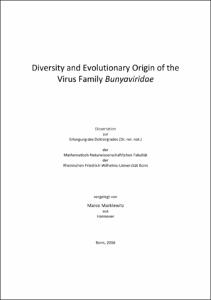Diversity and Evolutionary Origin of the Virus Family Bunyaviridae

Diversity and Evolutionary Origin of the Virus Family Bunyaviridae

| dc.contributor.advisor | Drosten, Christian | |
| dc.contributor.author | Marklewitz, Marco | |
| dc.date.accessioned | 2020-04-23T18:24:21Z | |
| dc.date.available | 2020-04-23T18:24:21Z | |
| dc.date.issued | 17.01.2017 | |
| dc.identifier.uri | https://hdl.handle.net/20.500.11811/7100 | |
| dc.description.abstract | The family Bunyaviridae is one of the largest groups of viruses and contains more than 350 taxa. Five genera are assigned to the family, namely Hantavirus, Nairovirus, Orthobunyavirus, Phlebovirus, and Tospovirus. Most bunyaviruses are transmitted by arthropods and share the common feature of dual host tropism for arthropods and vertebrates, with the exception of hantaviruses that are only found in mammals. Due to their role as agents of disease, bunyaviruses serve as suitable models to study vector-borne viruses. Until recently, viruses grouping outside the five known genera of the family Bunyaviridae were unknown. All bunyaviruses isolated from blood-feeding arthropods appeared to infect vertebrates. This thesis describes the discovery and characterization of six novel viruses that were isolated from tropical mosquitoes collected in Africa. The viruses share all typical bunyavirus characteristics such as a tripartite negative-sense genome and a cap-snatching activity during viral transcription. Sequence identity to other members of the family Bunyaviridae was up to 25% in the highly conserved region of the RNA-dependent RNA polymerase (RdRp) gene. RdRp sequence distances of the six novel viruses were almost equidistant to each other and to all established genera. In phylogeny the viruses established four unique deep branching lineages that shared ancient common ancestors with viruses from the vertebrateinfecting bunyavirus genera. The new lineages were proposed to define four new genera within the family Bunyaviridae, tentatively named Fera-, Gouko-, Herbe-, and Jonvirus. Gouko- and herbeviruses do not seem to encode the nonstructural proteins NSm and NSs which are present in their closest relatives, vertebrate infecting viruses of the genera Phlebo- and Orthobunyavirus, respectively. The NSs protein is an important pathogenicity factor and suppresses the antiviral immune response in vertebrates. In contrast to goukoand herbeviruses, jon- and feraviruses encode an NSs protein which, however, uses a coding strategy that has not been described in bunyaviruses before. It should be further investigated whether the NSs protein is able to interfere with the host´s antiviral RNAi response, as it has been reported for tospoviruses. Host restrictions were tested by infecting cell cultures from birds, mammals and reptiles. None of the cell cultures was permissive for any of the six novel viruses, suggesting host range restriction to insects. Concordantly, all novel viruses replicated in cell culture at ambient temperature but not at vertebrate-typical temperatures. These data suggest that fera-, gouko-, herbe-, and jonviruses represent the first insect-specific members of the family Bunyaviridae. The evolution of host tropism in the family was analysed by ancestral state reconstruction of host associations at the bunyavirus root and at all major lineage bifurcations. The results support the hypothesis that the vertebrate-pathogenic arboviruses evolved from ancestors that exclusively infected arthropods. Based on paraphyletic distribution of dual host tropism, the ability to infect vertebrates seem to have evolved several times convergently during bunyavirus evolution. Knowledge on the diversity and evolutionary origin of viruses may help to understand mechanisms of viral emergence and identify genes necessary for the infection of novel host species. | en |
| dc.language.iso | eng | |
| dc.rights | In Copyright | |
| dc.rights.uri | http://rightsstatements.org/vocab/InC/1.0/ | |
| dc.subject | Bunyavirus | |
| dc.subject | Virus Evolution | |
| dc.subject | Insect virus | |
| dc.subject.ddc | 570 Biowissenschaften, Biologie | |
| dc.subject.ddc | 610 Medizin, Gesundheit | |
| dc.title | Diversity and Evolutionary Origin of the Virus Family Bunyaviridae | |
| dc.type | Dissertation oder Habilitation | |
| dc.publisher.name | Universitäts- und Landesbibliothek Bonn | |
| dc.publisher.location | Bonn | |
| dc.rights.accessRights | openAccess | |
| dc.identifier.urn | https://nbn-resolving.org/urn:nbn:de:hbz:5n-45990 | |
| ulbbn.pubtype | Erstveröffentlichung | |
| ulbbnediss.affiliation.name | Rheinische Friedrich-Wilhelms-Universität Bonn | |
| ulbbnediss.affiliation.location | Bonn | |
| ulbbnediss.thesis.level | Dissertation | |
| ulbbnediss.dissID | 4599 | |
| ulbbnediss.date.accepted | 21.12.2016 | |
| ulbbnediss.institute | Medizinische Fakultät / Institute : Institut für Virologie | |
| ulbbnediss.fakultaet | Mathematisch-Naturwissenschaftliche Fakultät | |
| dc.contributor.coReferee | Misof, Bernhard |
Dateien zu dieser Ressource
Das Dokument erscheint in:
-
E-Dissertationen (4373)




